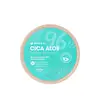What's inside
What's inside
 Key Ingredients
Key Ingredients

No key ingredients
 Benefits
Benefits

 Concerns
Concerns

No concerns
 Ingredients Side-by-side
Ingredients Side-by-side

Coptis Japonica Root Extract
Skin ConditioningButylene Glycol
HumectantSimmondsia Chinensis Seed Oil
EmollientPolyglyceryl-3 Methylglucose Distearate
EmulsifyingCetyl Ethylhexanoate
EmollientButylene Glycol Dicaprylate/Dicaprate
EmollientIsohexadecane
Emollient1,2-Hexanediol
Skin ConditioningCetearyl Alcohol
EmollientGlyceryl Stearate
EmollientButyrospermum Parkii Butter
Skin ConditioningSodium Acrylate/Sodium Acryloyldimethyl Taurate Copolymer
Emulsion StabilisingPolysorbate 80
EmulsifyingGlyceryl Caprylate
EmollientCoptis Japonica Root Extract, Butylene Glycol, Simmondsia Chinensis Seed Oil, Polyglyceryl-3 Methylglucose Distearate, Cetyl Ethylhexanoate, Butylene Glycol Dicaprylate/Dicaprate, Isohexadecane, 1,2-Hexanediol, Cetearyl Alcohol, Glyceryl Stearate, Butyrospermum Parkii Butter, Sodium Acrylate/Sodium Acryloyldimethyl Taurate Copolymer, Polysorbate 80, Glyceryl Caprylate
 Reviews
Reviews

Ingredients Explained
These ingredients are found in both products.
Ingredients higher up in an ingredient list are typically present in a larger amount.
1,2-Hexanediol is a synthetic liquid and another multi-functional powerhouse.
It is a:
- Humectant, drawing moisture into the skin
- Emollient, helping to soften skin
- Solvent, dispersing and stabilizing formulas
- Preservative booster, enhancing the antimicrobial activity of other preservatives
Butylene Glycol (or BG) is used within cosmetic products for a few different reasons:
Overall, Butylene Glycol is a safe and well-rounded ingredient that works well with other ingredients.
Though this ingredient works well with most skin types, some people with sensitive skin may experience a reaction such as allergic rashes, closed comedones, or itchiness.
Learn more about Butylene Glycol